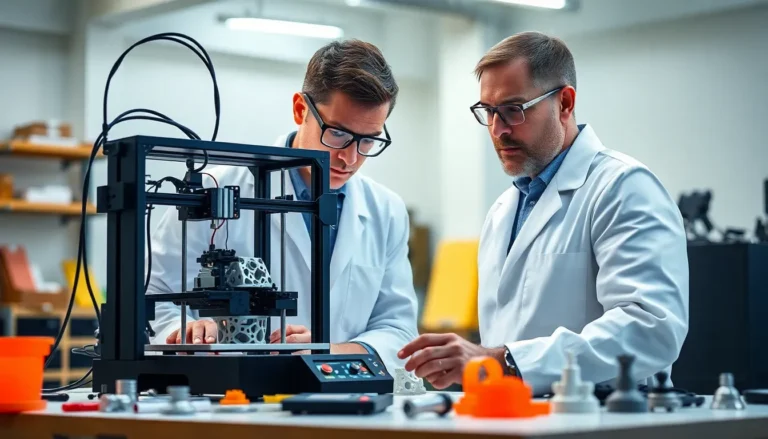In a world where everyone wants to stand out, 3D printed jewelry is the ultimate game changer. Gone are the days of cookie-cutter designs and mass-produced trinkets. Now, anyone can flaunt unique pieces that scream personality—without breaking the bank. Imagine wearing a ring that’s as one-of-a-kind as your cat’s Instagram account.
Table of Contents
ToggleOverview of 3D Printed Jewelry
3D printed jewelry represents a significant shift in the design and manufacturing process, providing an avenue for individualized expression. Customization stands as a key advantage; each piece can be tailored to capture personal tastes. This technology enables intricate designs that traditional methods often can’t replicate, allowing for unique shapes and details.
Cost efficiency is another notable benefit. Compared to conventional jewelry production, 3D printing reduces material waste and labor costs, making high-quality pieces more accessible. Many consumers appreciate the opportunity to acquire bespoke items at affordable prices.
In terms of materials, options abound. Jewelry makers use a variety of materials such as metal, resin, and even biodegradable plastics. This versatility results in different finishes and textures, enhancing the appeal of 3D printed jewelry.
Sustainability emerges as a critical component. The additive manufacturing process minimizes waste, aligning with the growing consumer preference for environmentally friendly products. Individuals seeking eco-conscious choices find this aspect particularly attractive.
Innovators in the jewelry industry often embrace technology to create unique collections. Artists leverage software to design complex pieces, ensuring that each creation stands apart in a crowded market. With a focus on individuality, designers appeal to consumers’ desires for authenticity and connection.
Market trends indicate a rising demand for personalized accessories. As more people choose to express their uniqueness through custom jewelry, the presence of 3D printed pieces is likely to expand. This transformation in the jewelry landscape highlights the capacity for technology to redefine personal expression.
Benefits of 3D Printed Jewelry

3D printed jewelry presents numerous advantages that cater to individual preferences and market trends. The accessibility of unique designs and eco-friendly materials sets this innovation apart from traditional methods.
Customization and Personalization
Customization allows consumers to create pieces that reflect their personal style. Unique designs often incorporate specific themes, symbols, or motifs tailored to individual tastes. Clients can collaborate with designers to pinpoint details such as sizes, shapes, or textures. The software used in 3D modeling makes the design process efficient and precise, ensuring a high level of detail. Significant advancements in technology enable intricate patterns that traditional jewelry-making methods can’t match. Consumers enjoy the freedom to choose materials, resulting in diverse finishes and aesthetics.
Cost-Effectiveness
Cost-effectiveness stands as a notable benefit of 3D printed jewelry. The production process optimizes material usage, significantly reducing waste compared to traditional methods. Labor costs decrease, as machines can perform tasks that previously required skilled artisans. As a result, high-quality items become more affordable for a broader audience. Many consumers appreciate the financial accessibility of bespoke jewelry, which deepens the appeal of uniqueness. The ability to produce small quantities without the need for mass manufacturing aligns well with current market demands. Ultimately, this approach fosters an environment where distinctive pieces thrive without a hefty price tag.
Popular Materials Used
Materials play a vital role in the appeal and functionality of 3D printed jewelry. The diverse options available cater to various preferences and needs.
Metals
Metals like stainless steel, bronze, and gold allow for durability and a premium look. Designers commonly utilize stainless steel for its resistance to tarnishing and scratching. Bronze captures attention with its warm tones and intricate details, while gold offers a classic elegance highly sought after in high-end pieces. Each metal can be polished or left with a raw finish, giving consumers choices in aesthetics. Inventors and artisans can also create unique alloys, enhancing the creative possibilities in jewelry design.
Plastics
Plastics such as nylon and PLA provide lightweight options for jewelry enthusiasts. Nylon is favored for its flexibility and strength, allowing for intricate designs without compromising durability. PLA, a biodegradable material made from renewable resources, appeals to environmentally conscious consumers. This sustainability aspect aligns with growing trends in eco-friendly fashion. Both materials can be dyed in various colors, making customization easy. The versatility of plastics keeps them popular in the growing market for 3D printed accessories.
Design Considerations
Design considerations in 3D printed jewelry encompass various factors that enhance both aesthetics and functionality. A modern approach leverages technology and materials to create unique expressions of personal style.
Software and Technology
Innovative software plays a crucial role in the design process. Programs like Rhino and TinkerCAD allow designers to create intricate 3D models with precision. Designers often use parametric modeling techniques to manipulate designs easily, providing endless customization options. Access to cloud-based collaborative platforms enables teamwork among designers and clients, streamlining the feedback process. Advanced printing technologies, including selective laser sintering and binder jetting, further enhance fabrication quality by delivering intricate details and finishes that elevate the final product.
Trends in Design
Current trends showcase an emphasis on organic shapes and geometric patterns. Many designers draw inspiration from nature, transforming elements like leaves or waves into beautiful jewelry pieces. Minimalism continues to dominate, focusing on simplicity and elegance that resonates with modern sensibilities. Additionally, personalization trends highlight initials and date engravings, which enhance sentimental value. A growing interest in mixed materials allows for unique combinations, such as metal and resin, appealing to diverse consumer preferences. These trends reflect the industry’s response to a demand for distinctiveness and individuality.
Case Studies of Successful Brands
Numerous brands have successfully integrated 3D printed technology into their jewelry lines. Tiffany & Co. stands out by leveraging 3D printing for prototypes, which allows rapid design iterations. This process speeds up collections while maintaining quality.
Shapeways, a significant player in the 3D printing space, offers a platform for designers to create custom jewelry. Independent creators can manufacture unique pieces, ranging from intricate necklaces to personalized rings, appealing to a wide audience. Their extensive material options cater to varied styles, enhancing customer satisfaction.
Jewelers’ Row in Chicago showcases boutiques that embrace 3D printing. These shops have expanded product offerings through intricate designs that traditional methods cannot achieve. This approach fosters a collaborative atmosphere where clients actively participate in the design process.
Viva La Jewels utilizes eco-friendly materials for sustainable practices. Their commitment to the environment resonates with consumers who prioritize sustainability. Each piece reflects a balance between artistry and responsible manufacturing.
Knyghts exemplifies the blend of luxury and technology in 3D printed jewelry. Their collections feature geometric patterns, appealing to modern consumers seeking distinct visuals. Enhancements in printing technology ensure that each piece meets high standards of durability.
MakersKit has tapped into the DIY market by providing 3D printing materials for jewelry enthusiasts. Customers can create custom pieces at home, making jewelry making more accessible. This empowers individuals to express their creativity like never before.
These brands highlight the broad potential of 3D printed jewelry. By combining technology with creativity, they redefine traditional jewelry markets. The ongoing evolution of consumer preferences continues to shape the industry’s landscape.
3D printed jewelry is revolutionizing the way individuals express their style and personality. With the ability to create custom pieces at an accessible price point, it’s no wonder consumers are drawn to these unique designs. The combination of innovative materials and advanced printing technology allows for intricate details that stand out in a crowded market.
As sustainability continues to influence consumer choices, 3D printed jewelry aligns perfectly with the demand for eco-friendly options. This trend not only enhances personal expression but also promotes a more responsible approach to fashion. The future of jewelry design is undoubtedly bright, as technology and creativity merge to redefine what it means to wear something truly unique.



